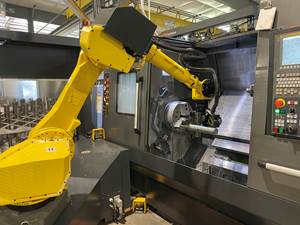Shop Glasses Offer Video and Data Capabilities
Here are some of the applications a manufacturer sees for real-time video streaming from the machine operator's point of view.
Share





Here is a detail that makes machine shops different from other workplaces: In a machine shop (and in certain other types of manufacturing plants), typically everyone is wearing eyewear. This is because safety glasses are required. Therefore, given that glasses are universal throughout the facility, could some set of capabilities be added to this eyewear that would aid the employees and advance the efficiency of the plant?
XOEye believes the answer is yes. The company sees real-time streaming video from the wearer’s point of view as part of the answer.
The four-year-old company was founded by manufacturing executive Chris Salow, who co-owns Michigan-based truck parts maker Peak Manufacturing. XOEye, based in Ann Arbor, has created and refined industrial glasses with data streaming capability by testing them at Peak. Testing has now been expanded to 25 other companies, which are proving out the glasses in applications including not just discrete parts manufacturing but also machine service and repair.
Anthony Blanco, XOEye’s chief business development officer, says real-time video potentially has a variety of applications on a plant floor. One is communication across a large facility. An employee facing a question or problem in production can quickly and easily share exactly what he or she is seeing with an engineer or manager (or a customer), who may be sitting far from the production floor or even at a different site.
Another application is training. A foreman overseeing a new employee could check in on that employee by dialing up the employee’s video feed and watching the work from that person’s point of view.
The eyewear would also be useful for capturing a record. The procedure for a given process or operation could be recorded as it is performed, either for purposes of documentation and accountability, or for recording the methodology of a job in case it is performed again.
The applications actually go well beyond manufacturing, Mr. Blanco says. Current development partner companies also include airlines and machine makers. A particularly appropriate user of the eyewear would be a field service technician who visits machine shops to repair equipment, he says. The glasses could be used to collaborate on a difficult service problem by sharing the view with an expert stationed back at the machine maker’s head office.
A company implementing the XOEye technology has various choices in how the system is configured. A likely setup would allow the wearer of the glasses to give permission (essentially by answering an incoming call) before someone else can see his or her point-of-view feed. Privacy is one reason for this, says Jim Beecham, XOEye implementation engineer, but another reason customization of permissions has to do with an issue affecting wearable data technology in a machine shop: the availability of Wi-Fi.
Production facilities do not necessarily have wireless Internet, and even if they do, they are often located far enough from population centers that even the best available bandwidth is small enough to be constraining. Therefore, part of tailoring this system to manufacturers is allowing users to be selective about when data are transmitted. The glasses offer the capability to capture video or snapshots offline for uploading later. In addition, Mr. Beecham says XOEye will work with individual plants to address their level of Internet access, in some cases installing on-site servers as part of the implementation.
Related Content
Same Headcount, Double the Sales: Successful Job Shop Automation
Doubling sales requires more than just robots. Pro Products’ staff works in tandem with robots, performing inspection and other value-added activities.
Read MoreThe Power of Practical Demonstrations and Projects
Practical work has served Bridgerland Technical College both in preparing its current students for manufacturing jobs and in appealing to new generations of potential machinists.
Read MoreAddressing the Manufacturing Labor Shortage Needs to Start Here
Student-run businesses focused on technical training for the trades are taking root across the U.S. Can we — should we — leverage their regional successes into a nationwide platform?
Read MoreShop Tour Video: You've Never Seen a Manufacturing Facility Like This
In the latest installment of our “View From My Shop” series, explore Marathon Precision’s multi-process approach to manufacturing, where blacksmiths and hand-forged dies meet state-of-the-art CNC machining. Discover how restoring classic muscle cars and building custom art projects creates a dynamic shop culture — and draws top talent to this unique and innovative metalworking facility.
Read MoreRead Next
AMRs Are Moving Into Manufacturing: 4 Considerations for Implementation
AMRs can provide a flexible, easy-to-use automation platform so long as manufacturers choose a suitable task and prepare their facilities.
Read MoreMachine Shop MBA
Making Chips and Modern Machine Shop are teaming up for a new podcast series called Machine Shop MBA—designed to help manufacturers measure their success against the industry’s best. Through the lens of the Top Shops benchmarking program, the series explores the KPIs that set high-performing shops apart, from machine utilization and first-pass yield to employee engagement and revenue per employee.
Read More





















